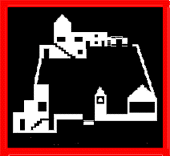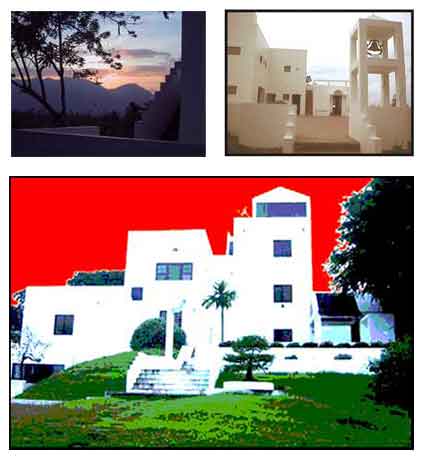|
Pulang Lupa is the peak of 50 hectares of hilly agricultural
land called Sitio Santol, or "Proses" (four roses)
to the old-timers, or the "Farm" to family, less than
2 kilometers from the town center of Tiaong, province of Quezon in the Philippines.
To kinfolk
and friends, Pulang Lupa is fondly referred to as the "Peak."
In the days of olde, after the family Easter mass, it would beckon
a traditional hike to the peak, an easy jaunt for the young ones
and a difficult uphill effort for the elders, their breathlessness
always rewarded by a paronamic vista of mountains and a verdant
countryside and their thirsts quenched by the milk of freshly
picked young coconuts.
Locals and old-timers refer
to the place as Pulang
Lupa because of the
color of volcanic soil found in abundance at the peak. Historically,
it has been called "Pinagbanderahan"
(Flag Site), where the
Japanese  held a strategic station during its provincial
occupation in World War II. The folklore is replete of buried
treasures the Japanese left behind, still undiscovered in tunnels
and caves in the bowels of Sitio Santol. Furtive diggings still
happen in the cloak of the dark of night. Some hunters come with
their treasure-seeking gizmos or third-eye psychics in tow. Others
try to establish contact for Japanese clients reported to be
brandishing authentic-looking maps. On occasion, talks reach
deep into the details of digging, security measures, and division
of the treasure. held a strategic station during its provincial
occupation in World War II. The folklore is replete of buried
treasures the Japanese left behind, still undiscovered in tunnels
and caves in the bowels of Sitio Santol. Furtive diggings still
happen in the cloak of the dark of night. Some hunters come with
their treasure-seeking gizmos or third-eye psychics in tow. Others
try to establish contact for Japanese clients reported to be
brandishing authentic-looking maps. On occasion, talks reach
deep into the details of digging, security measures, and division
of the treasure.
 Such
was the treasure mystique and allure that when the construction
for Pulang Lupa complex started in 1998, it was believed to be
a cover for a clandestine treasure hunt, the buildings to cover
the digging effort from nosy neighbors and the overhead view
from helicopters. Alas, through nine years of digging and construction,
no treasure has been found, just empty ammunition shells and
cul-de-sac tunnels. Still, psychics, third-eyes and treasure
hunters come, many pointing with great certitude on specific
spots. In the middle of a room: "Dig here, 5 by 5, and 12
feet down." Then adding: "It is so big." Or, the
'professional' treasure hunter boasting of successes with
previous treasure digs, contested monies tied up in Swiss accounts
armed with compass, caliphers, boxes with numbers, lights
and twitching needles, inquiring about where the sun rises and
sets, and was there ever a big tree around, applyiing his accumulation
of knowledge on Japanese modes of measures and markers, making
computations and convergences of lines, adding somberly import
and drama to it by a series of head-nodding, then points to a
spot in the middle of the courtyard: "Dig here, 6 tiles-square
and 10 feet down." A few even say, in animated awe, that
what lies beneath can pay off the national debt. Such
was the treasure mystique and allure that when the construction
for Pulang Lupa complex started in 1998, it was believed to be
a cover for a clandestine treasure hunt, the buildings to cover
the digging effort from nosy neighbors and the overhead view
from helicopters. Alas, through nine years of digging and construction,
no treasure has been found, just empty ammunition shells and
cul-de-sac tunnels. Still, psychics, third-eyes and treasure
hunters come, many pointing with great certitude on specific
spots. In the middle of a room: "Dig here, 5 by 5, and 12
feet down." Then adding: "It is so big." Or, the
'professional' treasure hunter boasting of successes with
previous treasure digs, contested monies tied up in Swiss accounts
armed with compass, caliphers, boxes with numbers, lights
and twitching needles, inquiring about where the sun rises and
sets, and was there ever a big tree around, applyiing his accumulation
of knowledge on Japanese modes of measures and markers, making
computations and convergences of lines, adding somberly import
and drama to it by a series of head-nodding, then points to a
spot in the middle of the courtyard: "Dig here, 6 tiles-square
and 10 feet down." A few even say, in animated awe, that
what lies beneath can pay off the national debt.
Nine years later, the Pulang
Lupa complex stands, a cluster of buildings atop this imagined
massive treasure: The main house, a library, an art gallery,
a big-enough courtyard for an endless variety of activities,
five guestrooms, a small 350-seat outdoor quarter -amphitheater,
an billiard/entertainment room and an open-outdoor chapel. (See:
Pulang Lupa Photos)
It houses the Pulang Lupa
Foundation that has been providing scholarships and education
assistance to needy students from the town of Tiaong. It provides
a place for activities of the communities that abut it and use
of the facilities for student needs: the library for research
and school work, the outdoor theater for rehearsals, the grounds for summer
camping activities. (See: Pulang
Lupa Foundation & Scholarships
and Educational Assistance Funds)
With the rest of Proses, it
has provided increasing sanctuary for birds (see Birdwatching)
and wildlife uprooted by a widening perimeter of commerce and
subdivisions. The land is also habitat for a large variety of
medicinal plants that has provided the abutting communities a
wild-crafted source for their traditional remedies (see Philippine
Alternative Medicine).
 Atop, the peak provides a panorama of
a vista found nowhere else in Tiaong, perhaps, even in the province
of Quezon. For the weary traveler in search of respite, it is
a place for solitude. To contemplate, to while away . . . . To
be engulfed by the sounds of birds. To indulge on a vista of
an unending circumference of mountains and the verdant rural
countrysides. . . the morning sunrises wrapped by wisps of awakenng
low lying clouds. . . . the capricious colors of the sunsets.
To be swept by the fierce and moaning amihan winds of the early
months. And at nights, there is the dome ablaze with a starry
spectacle of constellations and planets, and the recurrent moon
traversing the celestial arc. . . and the layers of sounds that
hide in the dark. Atop, the peak provides a panorama of
a vista found nowhere else in Tiaong, perhaps, even in the province
of Quezon. For the weary traveler in search of respite, it is
a place for solitude. To contemplate, to while away . . . . To
be engulfed by the sounds of birds. To indulge on a vista of
an unending circumference of mountains and the verdant rural
countrysides. . . the morning sunrises wrapped by wisps of awakenng
low lying clouds. . . . the capricious colors of the sunsets.
To be swept by the fierce and moaning amihan winds of the early
months. And at nights, there is the dome ablaze with a starry
spectacle of constellations and planets, and the recurrent moon
traversing the celestial arc. . . and the layers of sounds that
hide in the dark.
|


![]()
![]()

![]()
